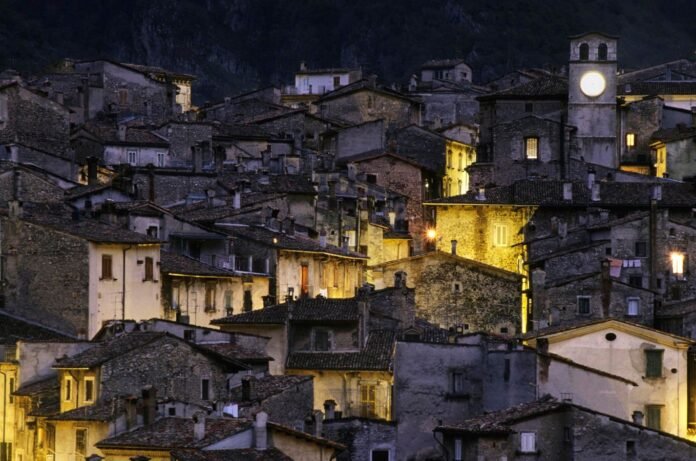Italy, abruzzo, scanno (Photo by: Universal Archive/Universal Images Group via Getty Images)
Given the onslaught of easily identified tourists who invade Italy’s major cities each summer, I have sworn off Italian cities like Rome, Florence, Naples and Venice in favor of exiting the autostradas and taking instead the off roads that lead to Italy’s small towns called borgos, which can be spied up in the hills or down in a valley, reached by winding two- or even one-lane roads that may well be crossings for a meandering flock of sheep unintimidated by the occasional car.
The small, quiet, winding streets are lined with homes with old wooden doors and flowers boxes.
In the region of Abruzzo, which stretches from the edge of Rome eastward to the Adriatic through snowy mountains and grand plains, all the way to the seashore, the territory is dotted with borgos with wonderful, punchy names like Pettorano sul Gizio, Opi, Tagliacozzo, Rivisondoli and Pescocostanza, whose streets may barely allow a Fiat 500 to pass through.
Lago di Scanno is a lake in the Province of L’Aquila, Abruzzo, Italy. It is located in the Appennino … More
Scanno, considered one of the most beautiful within the province of L’Aquila, is sequestered away in the Sagittaro Valley. A century ago it was an isolated village typical of Abruzzo’s economic deprivation, but that very isolation drew admirers like Edward Lear, who did sketches of the local lake for his Illustrated Excursions in Italy in 1846, and Henri Cartier-Bresson, who spent Christmas in Scanno in 1951 photographing the town in winter.
That lake, according to legend, was created after a local sorcerer and a witch had a feud that resulted in the latter falling to her death and causing a huge indentation in the earth that became filled with water.
Scanno, whose name derives from the Latin for its original stool shape, scramnum, is not rich with historic sights. The oldest seems to be the Eremio di Sant’Egidio (St, Giles) hermitage, which dates back well before its first mention, in 1612; it was restored in 1780 as a Romanesque country church with a modernized fresco alcove of the saint.
Woman wearing a traditional costume and holding a copper container, Scanno, Abruzzo, Italy, ca 1910.
Despite its size, the town has at least three other churches, as is typical in every borgo. One of the loveliest, for its permanent Nativity scene, is Santa Maria della Valle (Saint Mary of the Valley).
The real charm of Scanno is in walking a syeep slope, winding down from the main road then twisting and turning through streets prettied with flower boxes and well-maintained shuttered facades.
Befitting its reputation as a fine goldsmith’s town, the jewels of the town are very specific, with names like the presentosa––written of by Abruzzese poet Gabriele D’Annunzio in his esthete novel The Triumph of Death as “A large filigree star with two hearts in the middle”; the earrings with pearl pendants called circeglie, and the angel brooch called Cupid. The women of the town are also famed for their lace making.
Bucatini Pasta in Amatriciana Sauce. (Photo by: Eddy Buttarelli/REDA/Universal Images Group via … More
he food of Abruzzo has a range whose ingredients depend on the geography, so that cities on the coast have ample species of sea fish to sell, while land-locked Scanno, with its own blue lake, draws on lake fish––luccio (pike), tinca (tench) and persico (perch), and some of the best is cooked up at the rostisserie La Foce (Via deglie Alpini), known for its spaghetti with fat gamberi shrimp. The special gnocchi-like dumpling is called cazzelitt, and grilled lamb perfumes the air throughout the year. The Abruzzese love chili peppers they call diavolocchi (little devils) so much that many dishes using them are called all’abruzzese. By the way, the famous pasta dish of Rome, with hot peppers, amatriciana, actually comes from the far western border town of Amatrice in Abruzzo, and the traditional shape of fresh and dried pasta called ghitarra is cut on a stringed instrument resembling a guitar.
Ristorante L’Archetti in Scanno specializes in Abruzzese food and wines.
The wines of the province are largely Trebbiano d’Abruzzo and Montepulciano d’Abruzzo, which are increasingly being made better and better by young winemakers.
Scanno and its surroundings has about three dozen hotels and B&Bs, most costing under 100 euros per night. Some, like Hotel Acquevive, are located on the lake. Il Palazzois in an historic building in the town’s center. The B&B my wife and I booked, La Casa dei Nonni (Vico 2 Strada Silla), was modest indeed )fpr about 80 euros), with a shared bathroom, but conveniently in the center, and right around the corner was a very good Ristorante gli Archetti (Via Silla 8), set within the wine cellar of the Palazzo di Rienzo. The chef-owner is Michele Ruoppo, who uses as much Abruzzese provender, fish and meat as possible, and his extensive wine list carries more than three dozen Abruzzese wines.
Paccheri pasta with green pea sauce.
We enjoyed an antipasto of various local salumi and cheeses, then a rich pasta of pacchero macaroni in a verdant green pea sauce and spaghetti alla ghitarra cooked “risotatta,” that is, in the pan with minimal liquid, and a sauce of pecorino, licorice root and a confit of tomatoes, For the main course we had patanegra, the wonderful black pig of Europe. With the meal we drank a fine Montepuciano d’Abruzzo by the producer Fabulas, which in U.S. wine stores costs about $22 and here at the restaurant was only 25 euros. For dessert we shared a sfogliatina puff pastry with whipped cream, autumn fruits and Nutella.
Scanno is an easeful stop for anyone returning to Rome or the airport, for its calm and quiet and a populace unfazed by tourism makes it a fine way to end a vacation in Italy.







